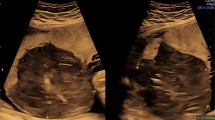Abstract
Chorangiosis is one of the vascular lesions that involvs terminal chorionic villi. It is commonly associated with various feto-maternal conditions like pre-eclampsia, diabetes etc. However, the clinical significance of this pathological finding has not been studied extensively. The aim of this study was to identify the various conditions associated with chorangiosis and to determine its clinical significance. A retrospective study to identify the cases of placentas diagnosed with chorangiosis was carried out and the clinical and morphological details of these cases were reviewed. Immunostaining for CD34 and muscle-specific actin was also performed to confirm chorangiosis and to exclude chorangiomatosis.
A total of 12 cases of chorangiosis were retrieved, most of them were of term gestation. Five of these 12 cases were associated with various maternal conditions including syphilis (2 cases) and single cases of pre-eclampsia, diabetes and jaundice. One case in each had abruptio placenta and non-immune hydrops. Of these 12 cases, seven were stillborn. Microscopically, all 12 cases showed extensive chorangiosis involving terminal villi. In addition, two cases showed focal infarction and one had extensive calcification. Immunostaining for CD34 confirmed increased number of capillaries while muscle-specific actin was negative, excluding chorangiomatosis.
The clinico-pathological profile presented in this study suggests that chorangiosis has characteristic pathological features for its recognition and needs to be differentiated from similar conditions like chorangioma and chorangiomatosis. Also, chorangiosis has potential clinical significance and should be mentioned in the pathology report and the patient should be investigated for associated conditions like syphilis, pre-eclampsia, diabetes etc.

Similar content being viewed by others
References
Altshuler G (1984) Chorangiosis: an important placental sign of neonatal morbidity and mortality. Arch Pathol Lab Med 108:71–74
Benirschke K, Franciosi R (1999) Placental pathology casebook. J Perinatol 19:393–394
Castellucci M, Scheper M, Scheffen P, Celona A, Kaufmann P (1990) The development of the human placental villous tree. Anat Embryol 181:117–128
Mutema G, Stanek J (1997) Increased prevalence of chorangiosis in placentas from multiple gestation. Am J Clin Pathol 108:341
Ogino S, Redline RW (2000) Villous capillary lesions of the placenta: distinctions between chorangioma, chorangiomatosis and chorangiosis. Hum Pathol 31:945–954
Pfarrer C, Macara L, Leiser R, Kingdom J (1999) Adaptive angiogenesis in placentas of heavy smokers. Lancet 354:303
Soma H, Watanabe Y, Hata T (1996) Chorangiosis and chorangioma in three cohorts of placentas from Nepal, Tibet and Japan. Reprod Fertil Devel 7:1533–1538
Author information
Authors and Affiliations
Corresponding author
Rights and permissions
About this article
Cite this article
Gupta, R., Nigam, S., Arora, P. et al. Clinico-pathological profile of 12 cases of chorangiosis. Arch Gynecol Obstet 274, 50–53 (2006). https://doi.org/10.1007/s00404-005-0076-0
Received:
Accepted:
Published:
Issue Date:
DOI: https://doi.org/10.1007/s00404-005-0076-0




